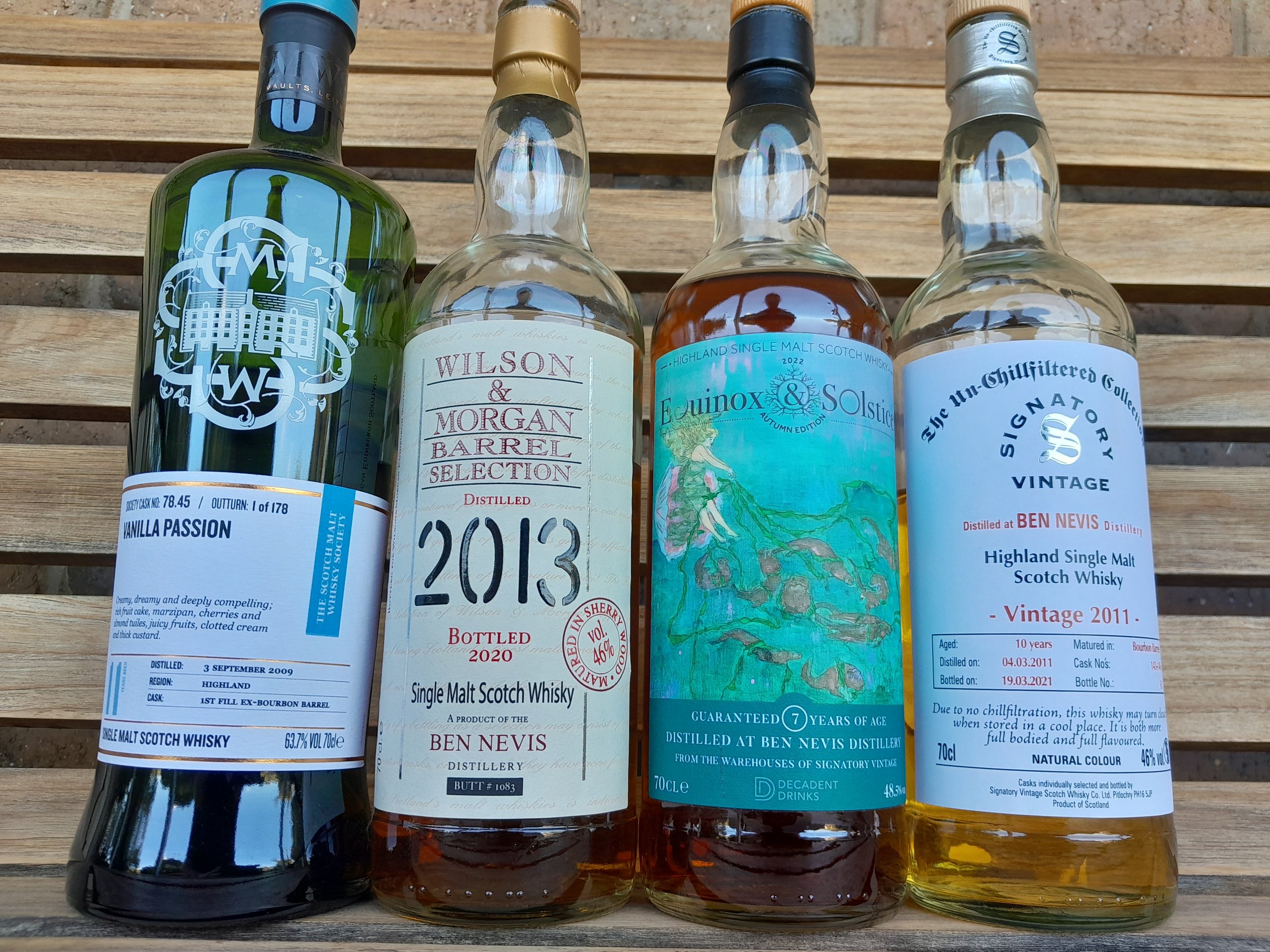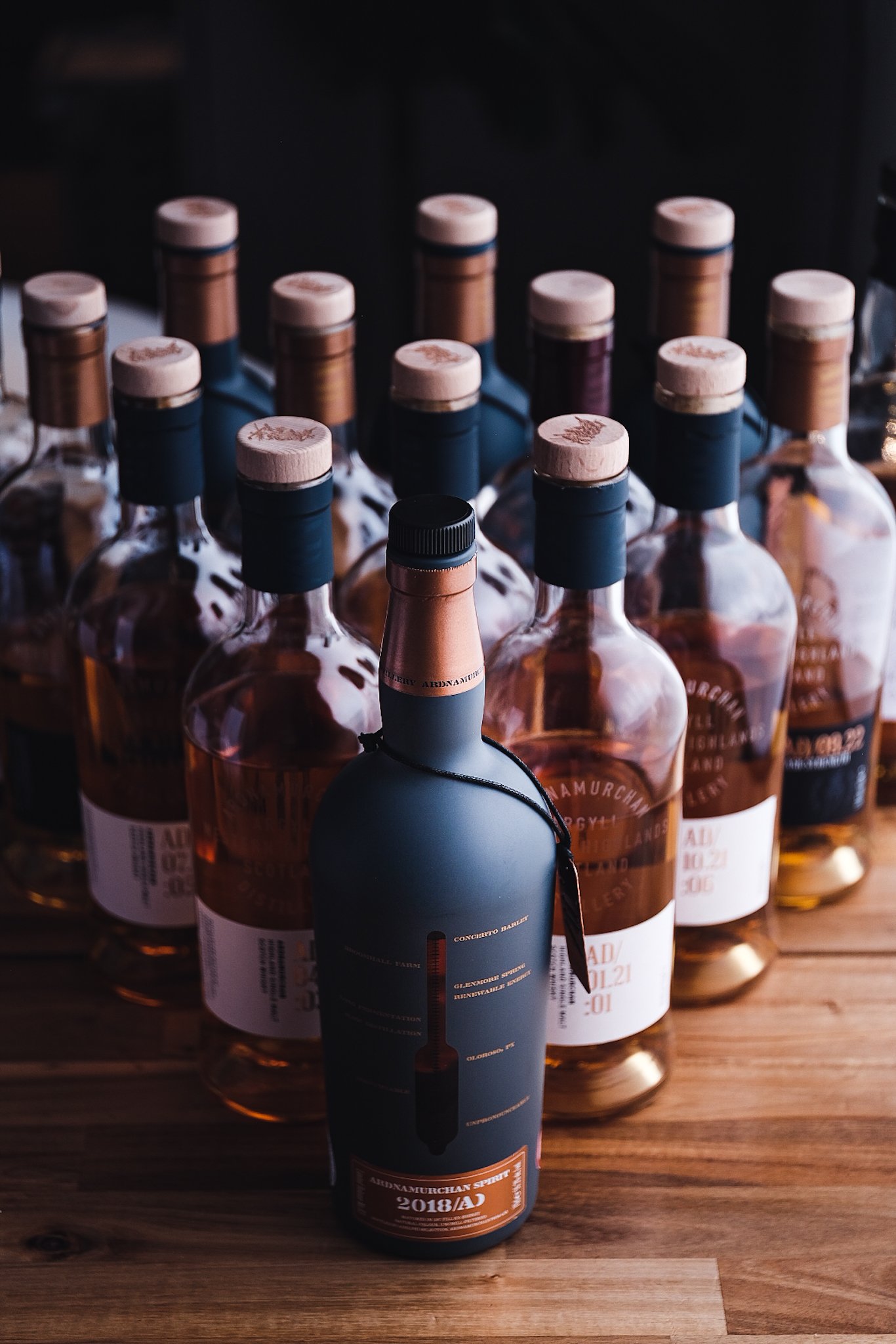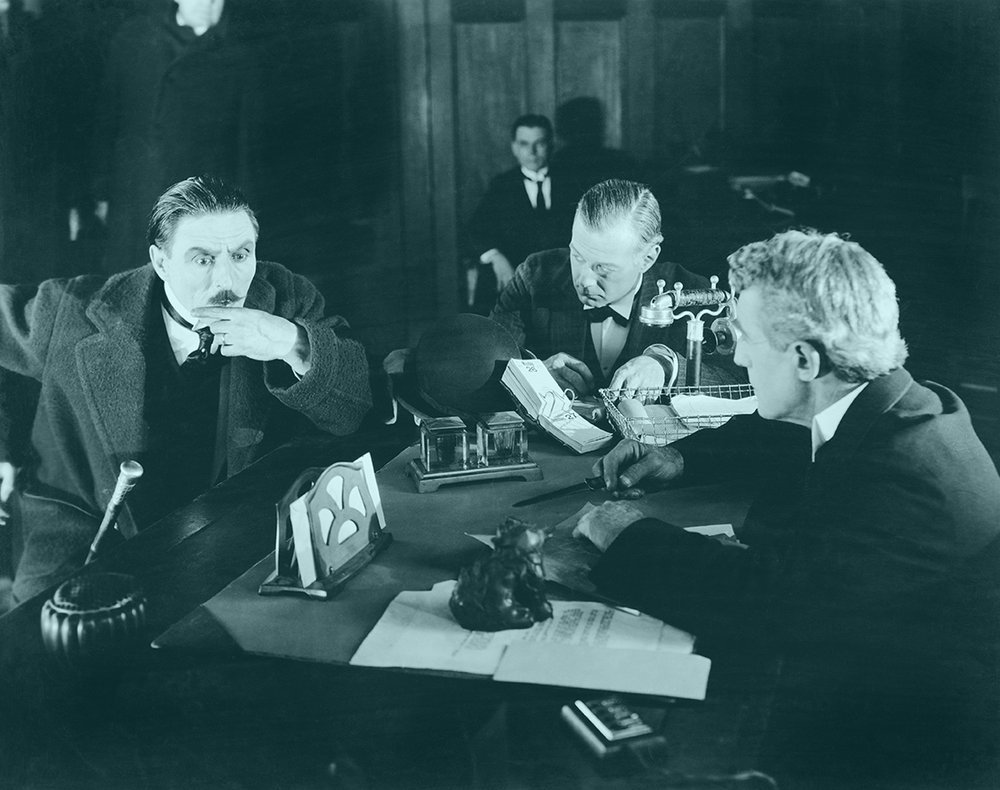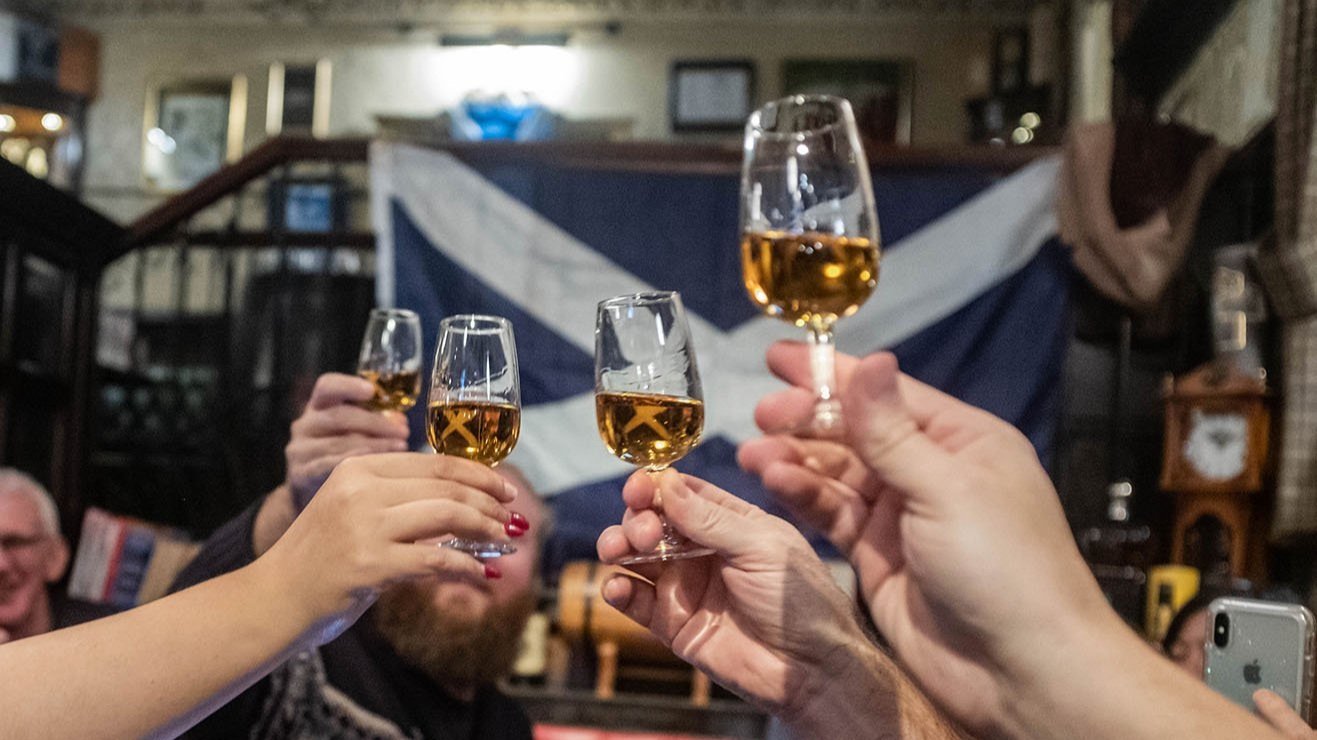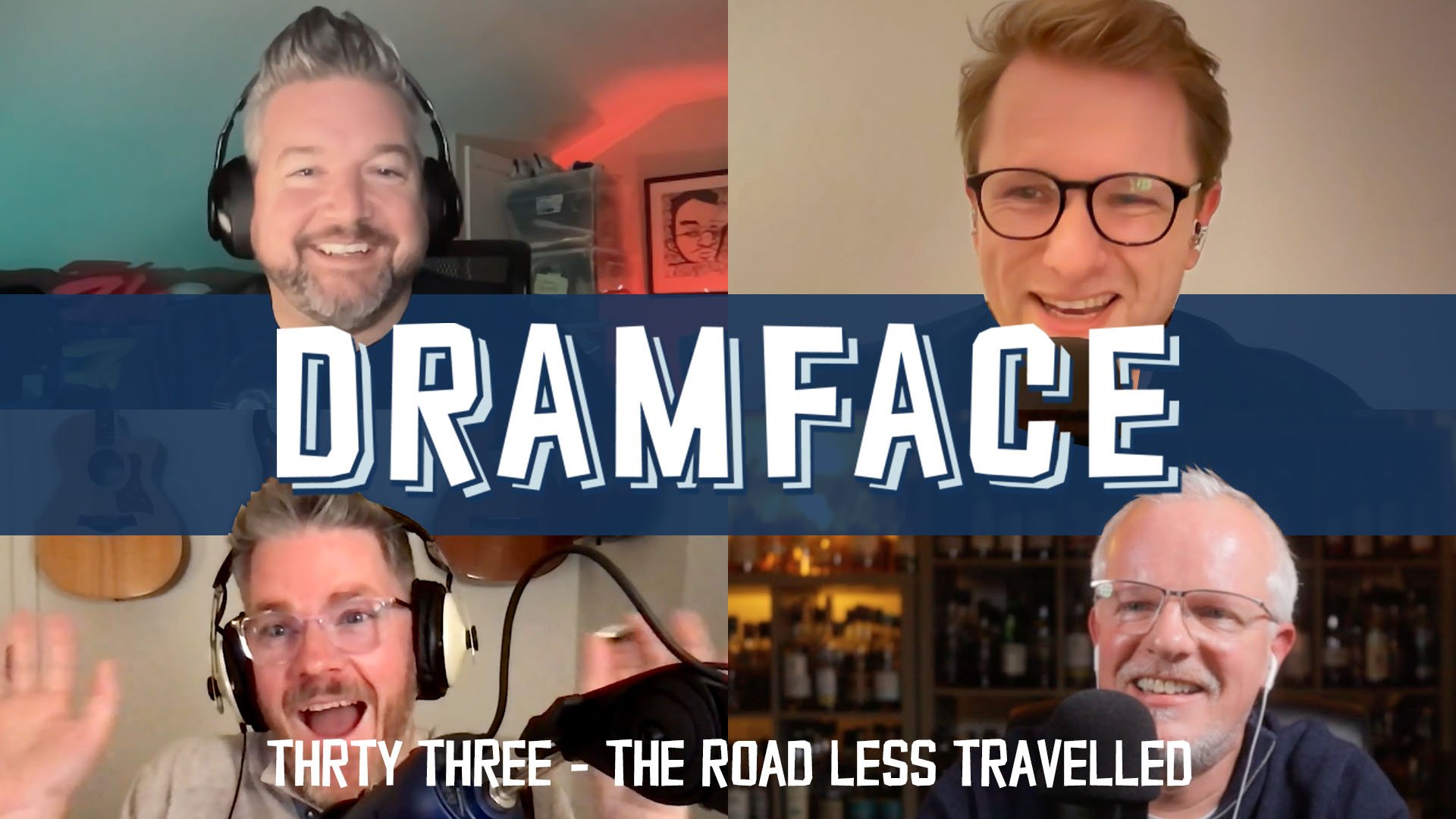Ben Nevis Indy Releases
Four Indies | Various ABV
Score: 7/10
Very Good Indeed.
TL;DR
IBs hold their own with this devil-may-care distillate
Let’s Follow Up..
In our last article on Ben Nevis, I wrote about blind challenges, blind competitions and how we can hone our palates for them. In this article, we’ll dwell for a moment on the impact of bias on our beliefs in whisky, as well as how we might test those beliefs.
Whenever we learn about almost any topic, it’s unavoidable that we must embrace a few fallacies. For instance, in learning about physics, we’re told in the early days — or at least I was — about the action of gravity as a mutually attractive classical force that operates between all massive bodies in the universe simultaneously. This conceptual simplification usually relies on an “action at a distance” model which we know to be false, though the idea of having to first explain general relativity and quantum mechanics in order to explain something as seemingly simple as gravity in our day-to-day lives is more than a little ludicrous. As a result, we must accept a certain degree of inaccuracy before we can advance our understanding to a point where we can rebuild it using more complex concepts.
In my very limited experience, whisky follows the same principle. We initially learn certain details which don’t hold up in time — the classic aspects of regionality, for one. Of course, we know not all Islay malts are smoky, and not all Speysiders are all elegant or fruity, and the idea that we should conflate all non-Islay island malts with Highland mainlanders is reductionist to say the least. Still, giving some easily understandable definitions which are usually more true than false helps to foster interest. That initial interest gets bodies in the door and sells tickets for tastings and festivals, in turn justifying jobs in the industry.
It does bother me a bit, though, the use of these little apocrypha in marketing. Many distilleries make claims about this or that whisky being entirely unique due to their location or their use of some exclusive loch or burn. Don’t get me wrong: water profiles are important, but do we really expect to be able to identify distilleries by that? Often these claims are just artistic licence applied to romantic language; other times, they signal a crafty attempt at fostering a USP. No, I didn’t quite use the T word this time…that debate’s already been had elsewhere on Dramface. 😉
Claims aren’t just made by distilleries and marketing departments, though: many enthusiasts get caught in the deep end of whisky enthusiasm and entangled in its manifold minutia. I’ve certainly been there many times. This niche-of-a-niche thinking can lead to some very enclosed thinking which, if supported by others in the community, results in the oft-referenced echo chamber. This isn’t necessarily a bad thing, just something to be aware of.
One of the claims we encounter with pretty reasonable frequency is the notion that distilleries have obvious vintage characteristics. Older bottlings often fetch high prices these days, of course, but particular distillation years fetch more than others with certain distilleries: 1972 Brora, 1964 Bowmore, 1976 Ardbeg, and lately, 1996 Ben Nevis. Now, not having had the pleasure of trying any of these whiskies, let alone multiples from the same vintage or their counterparts in vertical, I really have no basis for forming any strong opinions on the matter.
What I would point out, though, is a trio of factors: firstly, with any claim, the burden of proof is on the claim, not the disproof of said claim. Secondly, old and/or small-batch IB bottlings inevitably have a degree of rarity attached, and any claims correlating quality with rarity ought to be met with scepticism. Thirdly, particularly for old bottlings, reputation is everything. If the right reviewers and/or “influencers” (I detest that word, by the way) determine that a particular bottling or vintage is excellent, then it cannot be helped that others follow those opinions. That isn’t any critique of character or derision of social behaviour, merely a fact: we are social creatures and thus generally inclined to group-think.
All this isn’t to say that we don’t see variation in distillate over the years. Of course, if some production parameter is changed, that has an influence on the whisky; it makes sense that it should smell and taste different. For instance, a change in yeast selection, source of casks or distillation regime ought to impact the product. Even then, if an assertion is made that the character has changed, we should do our level best to test that hypothesis. The mechanism for this is, of course, blind tasting.
To reduce the risk of confounding variables, such claims of vintage effect (whatever the purported cause) ought to be tested by blind tasting. Multiple bottlings of said vintage at a given age range and from a given cask type ought to be pitted against similar age/cask contemporaries from nearby years (i.e. a combination of horizontals and verticals). This reduces the risk of cask-to-cask variation skewing the results; the more representative samples of each given year being tested, the larger the confidence interval given to the data.
That kind of tasting isn’t what we’re here for today though… Rather, I thought we might have a very casual and non-positing look at how a few indies stack up against their OB counterparts.
Ben Nevis is one of those characterful distillates that I believe works with a variety of cask types, though I’ll confess a partiality to a combination of bourbon cask and Oloroso: it brings out the best of both the tropical fruit esters and the meaty, savoury and autolytic qualities almost endemic to the ‘Nevis.
Review 1/4
Ben Nevis 11yo, SMWS ‘78.45 Vanilla Passion,’ 63.7% ABV
Paid AUS$190
Score: 4/10
Some promise.
TL;DR
Decent, but in an obtrusive cask
Nose
Something ubiquitous to SMWS first-fill bourbon casks: a certain fatty vanilla/butter quality (indeed, it’s bourbon-esque) with baking spice, plus juicy fruits and tones of apple crumble pie dusted with Demerara. Custard and perhaps just a small trace of something savoury/sooty, with perhaps psychosomatic traces of instant mie goreng powder and a slight oiliness. Hint of the milk bottle lollies I'm always finding in these SMWS bourbon casks as well.
Palate
Drinks pretty easily for the ABV, but anaesthetisation is unavoidable without a touch of water: after my first sip, I brought this down by about 5% ABV, and I continued to play with reduction over time (sweet spot was around 55% IMHO). Definitely a touch of something savoury in there, but to me this confirms that Ben Nevis needs some sherry influence to fully realise its house style. There’s a touch of earthy moss complementing the fruits, vanillas, spices, and Demerara. Again, a little tertiary milk bottle plus rich coconut flesh, maybe some burnt orange oil plus white pepper, a smidge of creamy Dijon mustard, and a fat oiliness: good distillate, even if it misses some of the true umami/autolysis that makes BN stellar.
The Dregs
Not a bad bottling at all. Some of the distillery’s signature character shines through, but the oak is a touch intrusive. For fans of sweeter drams which rely on more oak character, this is sure to be a zinger, however I would have preferred another 5 to 10 years in a refill cask instead, or perhaps a re-racking into refill sherry around year 8 or 9. Also, the price is a little cheeky for the age, though that’s hardly surprising in a notable distillery release from the SMWS: still, it gets rounded to the lower point here. Ah well, I’m not employed by them, and they certainly didn’t bottle this specifically for me, it’s just a mild shame that some distillery flair is buried under vanilla and coconut. Onto the next then…
Score: 4/10 TK
Review 2/4
Ben Nevis 10yo, Signatory Vintage Un-Chillfiltered Collection, 2011 Bourbon Cask, 46% ABV
Paid AUS$100
Score: 5/10
Average.
TL;DR
Malty, oily, and clearly a Ben Nevis
Nose
Plenty of maltiness with barley sugar, oat cakes, blonde ale wort and a little syrupy-chalky children's medicine. Also good vanillas, a touch of beeswax, some ripe white stone fruits, pear, lemon zest and just a touch of soot. A very “Easy” start for a BN.
Palate
Credit due: a nice, moderately oily mouthfeel. More of those vanillas, a few sweet white florals, white pepper, and a trace of varnish. More barley worts and malt syrups, and similar white fruits to the nose but with implications of cool climate Chardonnay — some grapiness, I guess? A hint of some oily dirtiness that’s possibly psychosomatic, along with condensed milk/coconut lactones. A very light and easy profile.
The Dregs
From previous experience, I can say that this does stand out as a Ben Nevis when inserted in a blind line up with cleaner, unpeated bourbon cask driven drams (prototypical Speysiders, one might generalise), but outside that context this bottling doesn’t deliver much of the distillery DNA. Or at least not to this shoddy palate. Still, it’s a well put-together dram at a respectful price point with good flavour and a better than average mouthfeel for its stats. An easy, go-to, daily drammer.
Score: 5/10 TK
Review 3/4
Ben Nevis 7yo, Decadent Drinks Equinox & Solstice, 2nd-fill Sherry Butt, 48.5% ABV
Paid AUS$170, limited availability
Score: 7/10
Very good indeed.
TL;DR
Nose
Rich Oloroso — glad it was a second fill. Dried fruits in the usual vein of dates and figs with a touch of cranberry jam. Fruits aside, there’s spices — nutmeg, vanilla and cinnamon — with mild Amburana infusion spirals. Plus oily roasted nuts, golden syrup, and fleeting dark chocolate. The distillery character pushes through with good autolytic soy/Vegemite tones plus a little yeastiness. Continues with Nevis’ prototypical dirtiness (read organosulfurs) leaning toward beef broth and passionfruit with some accents of boot polish and old leather.
Palate
Sweeter oak than the nose implies, but with a good ratio of spirit and cask. The oak is back with more of the same spices plus cacao and cedar while the sherry fruits are slightly more restrained. The distillate is louder here too, still pleasantly dirty, autolytic, and meaty but also adding some malt geared towards Werther’s Originals, as well as esters à la mango and more passionfruit. A nice balance between oily and textural mouthfeel with juicy fruits — not immensely complex, but a well composed sip.
The Dregs
This is a ripper, probably beyond what the score indicates. As is becoming frustratingly common though, the pricing lets things down a touch: for a 7yo single malt at less than cask strength, it’s an up-hill battle. RRP on this locally was over $200AUD, and I simply wouldn’t have bought it at that price. Part-owner of Decadent Drinks Angus MacRaild has touched on pricing in the past, and I feel for all the bottlers struggling to find good casks from top tier distilleries at a reasonable cost. Still, even compared to many peer bottlings, it’s a hefty fee: whether importers and distributors are playing off Angus’ reputation to jack prices across the board is unknown, however I remain constantly wary of reputation and hype being utilised for marketing purposes. It is what it is, and this is indeed some very tasty whisky.
Score: 7/10 TK
Review 4/4
Ben Nevis 7yo, Wilson & Morgan 2013, Refill Sherry Butt, 46% ABV
Paid AUS$120
Score: 7/10
Very good indeed.
TL;DR
Dirtier, meatier and great value. This takes the top position here
Nose
Unsurprisingly, there are similarities to the E&S from the start. Vegemite on burnt toast, hot brake pad, yeast cake from an old bottle of stout, and characterful, meaty organosulfurs (which is probably a partial cask contribution — if so, it’s very well executed). Otherwise, there's a touch of proper balsamic, a few dried fruits, chocolate roasted malt at mash-in, orange blossom honey, WD-40, walnuts, and burnished copper.
Palate
Baker's chocolate, yeasty ale made with brown-black spectrum malts, a hint of cumin spices with mild dried fruits, vanilla, BBQ meats, roasted almonds, Habano wrapper, orange liqueur, trace gunpowder, fermenting berries, and a moderate tannic oak finish. Less aromatic than the E&S perhaps, but a slightly denser and more savoury composition which ticks many of my boxes.
The Dregs
Overall a touch dirtier and meatier with fewer tropical fruits and “typical” sherry tones than the E&S. Both are immense bottlings for different reasons and equally satiate my desire for punchy distillate through a sherried lens. The lower cost of entry (at time of purchase, at least) and my proclivity for slightly drier profiles drag the W&M to the top end of the point, whereas the high price point of the E&S has it sitting more squarely in the middle.
Score: 7/10 TK
Tried these? Share your thoughts in the comments below. TK
-
Dramface is free.
Its fierce independence and community-focused content is funded by that same community. We don’t do ads, sponsorships or paid-for content. If you like what we do you can support us by becoming a Dramface member for the price of a magazine.
However, if you’ve found a particular article valuable, you also have the option to make a direct donation to the writer, here: buy me a dram - you’d make their day. Thank you.
For more on Dramface and our funding read our about page here.

